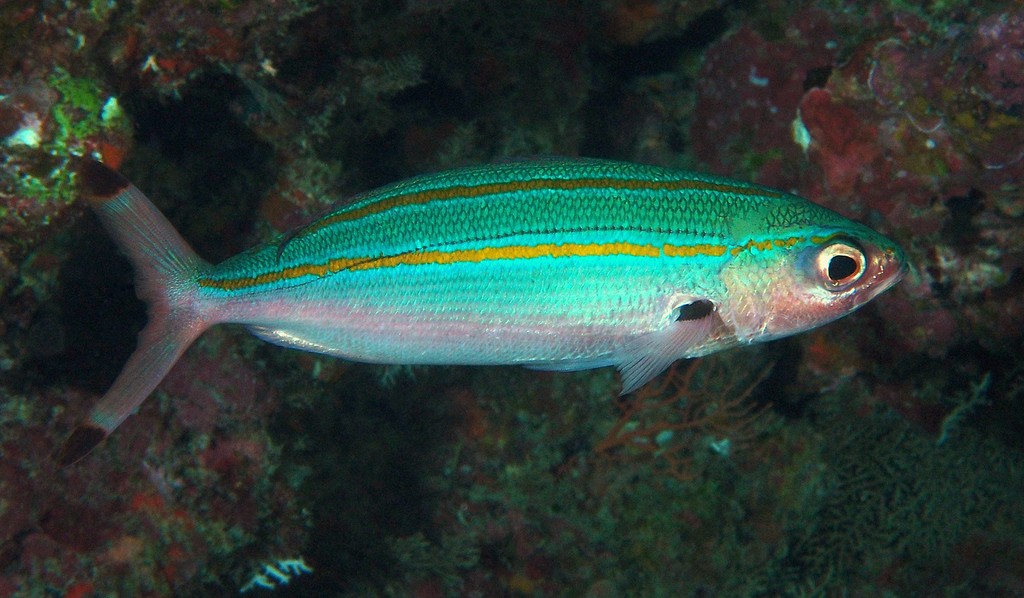PTEROCAESIO DIGRAMMA - (BLEEKER, 1864)
Actinopterygii (Gigaclass) > Actinopteri (Class) > Teleostei (Subclass) > Lutjaniformes (Order) > Lutjanidae (Family) > Lutjaninae (Subfamily) > Pterocaesio (Genus)
Fusilier à deux bandes jaunes, Darkbanded fusilier, Black-tipped Fusilier, Black-tip fusilier, Two-sptripe Fusilier, Yellow-striped fusilier, Twin Yellow-striped Fusilier, Double stripe fusilier, Doubleline Fusilier, Double-lined fusilier, Dobbeltlinjet musketerfisk, Fusilero de dos bandas, Gurukun, Nisen-takasago, Takasago, タカサゴ, بُندُقِية بأَشْرطَتَيْنِ صفراء, 乌尾冬仔, 雙帶梅鯛, 双带鳞鳍梅鲷, Cá Chàm mốc,
Synonymes
Caesio diagramma (Bleeker, 1864)
Caesio digramma (Bleeker, 1864)
Pterocaesio diagramma (Bleeker, 1864)
---------------------------------------------
Description
Dorsal spines (total): 10; Dorsal soft rays (total): 14-16; Anal spines: 3; Anal soft rays: 11-12; 4-5 scales on cheek; 24-31 predorsal scales; scaled dorsal and anal fins. Upper peduncular scale rows usually: 12 or 13 (11-14); lower peduncular scale rows usually: 16 or 17 (16-18). Post maxillary with 2 processes; posterior end of maxilla tapered. Head length 3.0-3.5 in SL; body depth 3.5-4.1 in SL. Max length: 30.0 cm TL. Depth range: 0 - 50 m.
Color
Body blue to greenish dorsally, white ventrally. With two thin yellow to orange lines; lower line mostly just below lateral line. Black tips on caudal fin. A broad process on ventrolateral surface of basioccipital for attachment of Baudelot's ligament, extending ventrally beyond a horizontal with condyle's rim, adjacent to condyle.
Etymology
Pterocaesio: from Greek, pteron = wing, fin + from Latin, caesius = blue-grey or bluish-grey.
digramma: from Greek, di or dis = two, double, twice + from Greek, gramma = mark.
Original description: Caesio digramma Bleeker, 1864 - Type locality: Ambon Island, Molucca Islands, Indonesia.
Distribution
Indo-West Pacific: eastern Malaysia east to New Ireland (Papua New Guinea) and Vanuatu, north to Ryukyu and Ogasawara islands, south to northern Australia and New Caledonia.
Biology
Found in coastal areas, primarily around coral reefs, turning bright red. Feed on zooplankton in midwater aggregations. Oviparous, with numerous, small pelagic eggs.
Similar species
Pterocaesio marri (Schultz, 1953) - Reported from New Caledonia - Link to the species (here) - Pair of thin yellow stripes on side, the lower covering lateral line for most of its length.
Fusilier à deux bandes jaunes, Darkbanded fusilier, Black-tipped Fusilier, Black-tip fusilier, Two-sptripe Fusilier, Yellow-striped fusilier, Twin Yellow-striped Fusilier, Double stripe fusilier, Doubleline Fusilier, Double-lined fusilier, Dobbeltlinjet musketerfisk, Fusilero de dos bandas, Gurukun, Nisen-takasago, Takasago, タカサゴ, بُندُقِية بأَشْرطَتَيْنِ صفراء, 乌尾冬仔, 雙帶梅鯛, 双带鳞鳍梅鲷, Cá Chàm mốc,
Synonymes
Caesio diagramma (Bleeker, 1864)
Caesio digramma (Bleeker, 1864)
Pterocaesio diagramma (Bleeker, 1864)
---------------------------------------------
Description
Dorsal spines (total): 10; Dorsal soft rays (total): 14-16; Anal spines: 3; Anal soft rays: 11-12; 4-5 scales on cheek; 24-31 predorsal scales; scaled dorsal and anal fins. Upper peduncular scale rows usually: 12 or 13 (11-14); lower peduncular scale rows usually: 16 or 17 (16-18). Post maxillary with 2 processes; posterior end of maxilla tapered. Head length 3.0-3.5 in SL; body depth 3.5-4.1 in SL. Max length: 30.0 cm TL. Depth range: 0 - 50 m.
Color
Body blue to greenish dorsally, white ventrally. With two thin yellow to orange lines; lower line mostly just below lateral line. Black tips on caudal fin. A broad process on ventrolateral surface of basioccipital for attachment of Baudelot's ligament, extending ventrally beyond a horizontal with condyle's rim, adjacent to condyle.
Etymology
Pterocaesio: from Greek, pteron = wing, fin + from Latin, caesius = blue-grey or bluish-grey.
digramma: from Greek, di or dis = two, double, twice + from Greek, gramma = mark.
Original description: Caesio digramma Bleeker, 1864 - Type locality: Ambon Island, Molucca Islands, Indonesia.
Distribution
Indo-West Pacific: eastern Malaysia east to New Ireland (Papua New Guinea) and Vanuatu, north to Ryukyu and Ogasawara islands, south to northern Australia and New Caledonia.
Biology
Found in coastal areas, primarily around coral reefs, turning bright red. Feed on zooplankton in midwater aggregations. Oviparous, with numerous, small pelagic eggs.
Similar species
Pterocaesio marri (Schultz, 1953) - Reported from New Caledonia - Link to the species (here) - Pair of thin yellow stripes on side, the lower covering lateral line for most of its length.
